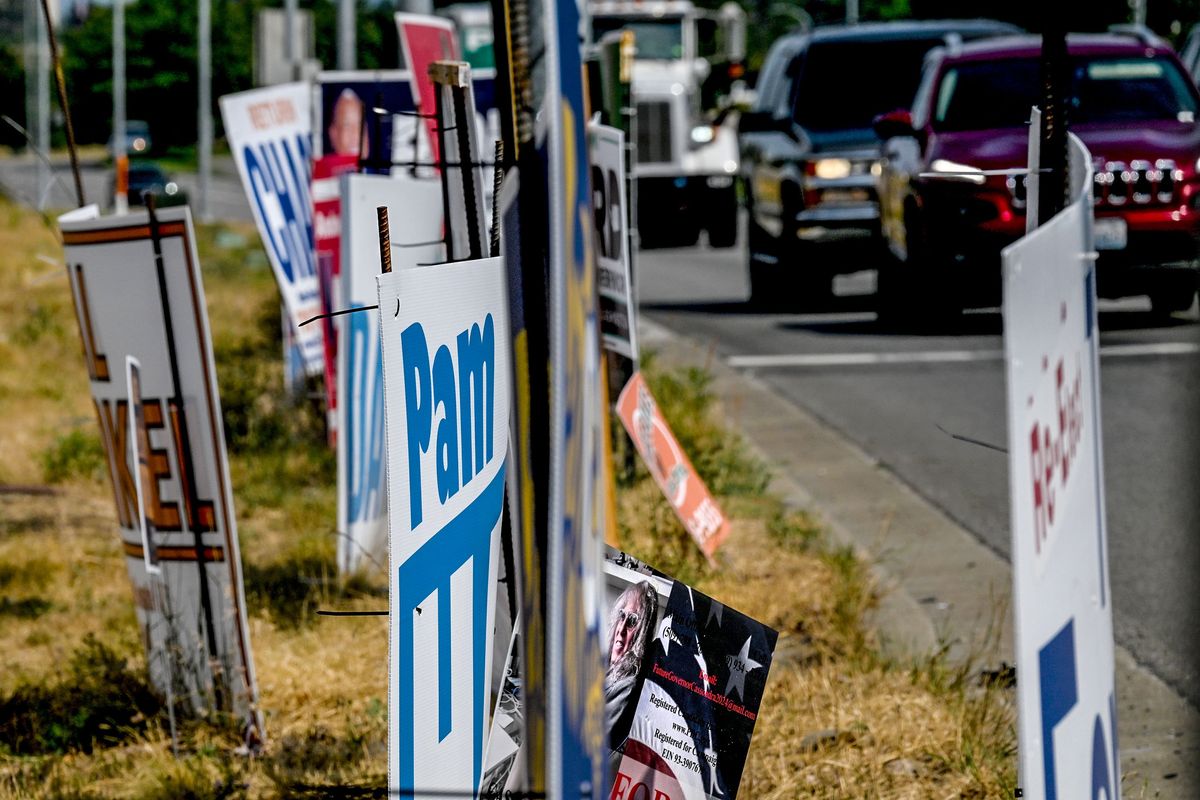A ‘campaign staple’: Signs with candidates’ names line the streets, but do they really work?

A plethora of campaign signs decorate front yards and dry grass patches along arterials – it’s a familiar sight , especially in the late summer and early fall of election years.
With the primary election underway and a major presidential cycle on the horizon, it’s no surprise that the dozens of names appearing on the ballot are also being spotted on signs across cities and counties.
On one grass hill near Interstate 90 in the Spokane Valley, signs appear for Dr. Bernadine Bank, Michael Baumgartner and Rene Holaday, among others – three candidates vying for the 5th Congressional District seat.
Clusters like this often include candidates from the left and right.
In light of this chaotic collection of names, signs may be diluted, but that’s not of concern, according to Kieran Sprague, the manager of the Maycumber for Congress campaign. Distributing signs “is not as much a matter of trying to stand out, rather (than it is) a repetition exercise,” he said in an email.
Jacquelin Maycumber is another 5th District candidate.
That perspective echoes a Vanderbilt University study published in 2011.
Political science experts created “a fictitious county council candidate” named Ben Griffin, NPR reported. Nominal signs were placed around lawns in the tested jurisdiction, and within a week, a survey was sent to residents of the neighborhood asking for them to “list their choices for the county’s at-large council seats.” Griffin’s fake name appeared with a handful of serious candidates.
Results were unexpected: “Nearly a quarter of respondents listed the fictional Ben Griffin among their top three picks.”
Such findings are one of many factors that build a case for campaign signage.
Emily Strode is a campaign consultant who previously served as Rep. Cathy McMorris Rodgers’ general consultant.
Strode’s strategy is to advise candidates “to try to get signs actually in yards” as opposed to near rights-of-way. This targeted approach not only shows that the candidate has supporters who are proud to display their loyalty, but it allows for the observer to view the sign in a standalone setting.
Strode, though, said signs may only be helpful in local elections.
“I’ve noticed – you look at Sen. Patty Murray, for example – I don’t think I’ve ever seen a yard sign for her in Spokane County, yet she wins cycle after cycle,” she said.
For Strode, that indicates billboards and signs “don’t win elections.”
Bank’s campaign has four ongoing billboards across the 5th Congressional District: one in Walla Walla, another in Colville and two more that bounce around Spokane County.
Campaign manager Bajun Mavalwalla believes signs function partly as “a metric of legitimacy,” noting Bank’s signage is “an important way to communicate to voters that (she) is a serious candidate.”
Signs serve as a baseline “milestone” for candidates. But they also build momentum and name recognition, according to McMorris Rodgers’ former campaign manager, John Estey.
“They’re a campaign staple at this point,” he said.
When it comes to placing signs, most campaigns tend to prefer private property for the reasons Strode mentioned. Another consideration is that political signs on public land are required to be in compliance with state and local policies, which may pose an additional challenge.
Knowing the ideal locations often boils down to “institutional knowledge,” Estey said.
Nonprivate sign hot spots include high-traffic intersections and empty dirt plains across Spokane.
Not all signs were strategically placed by campaigns . Volunteers play a crucial role in creating political displays for candidates, too.
Upkeep of the signs is also important. Natural and intentional damage is something “you certainly do worry about,” Estey said.
“When they do get vandalized, when they do get ripped down on the campaign trail, you do have to make sure that those signs get either fixed or completely taken down.”
At least in Strode’s career, it’s not common for campaigns to target districts with partisan leanings “at that granular level.” For example, it would be unlikely for a Republican campaign to focus signage only in red areas or to pinpoint left-leaning neighborhoods with a goal of swaying voters.
One common thread between all campaigns is that they place greater significance on voter engagement with candidates. Signs, both Strode and Estey said, would have more impact if campaigns ran in vacuums – but they don’t.
Information collected by DHM Research, a Pacific Northwest-based independent firm, found voters rarely let signage dictate their ballot. In a July study, DHM found that 59% of surveyed Eastern Washingtonians strongly disagreed with the statement, “seeing political signs in my neighborhood influences my voting decisions.” Less than 1 in 4 responded with either strongly or somewhat agree.
Voters may not be convinced by a sign alone, but campaigns won’t be ending sign production anytime soon. Sprague said that signage holds its own value.
“For a relatively low cost,” Sprague said, “you have the opportunity to get your candidate’s name in front of a larger, captive audience on a daily basis.”